Business Laws 2: A Comparative Analysis of Crowd Funding Legislation
VerifiedAdded on 2020/03/16
|9
|2296
|36
Report
AI Summary
This report provides a comprehensive analysis of crowd funding, beginning with its definition and operational process, highlighting its increasing popularity in the business world. It explores how crowd funding functions by collecting small donations from the public to initiate new business plans, often leveraging social media and online platforms to reach potential investors. The report then delves into successful crowd funding campaigns in Australia, including the 'Flow Hive' project and CORENA, showcasing the diverse applications and impact of crowd funding. A significant portion of the report is dedicated to comparing crowd funding legislations of Australia, New Zealand, the United States, and the United Kingdom, with a focus on the Corporations Amendment Crowd Sourcing Fund Act of 2017 in Australia. The comparison examines the regulations concerning equity shares, investor protection, and the limitations imposed on companies, offering insights into the advantages and disadvantages of each jurisdiction's approach. The report concludes by emphasizing the benefits of crowd funding for both entrepreneurs and investors, while acknowledging the need for robust legislation to prevent fraudulent activities and ensure ethical practices.
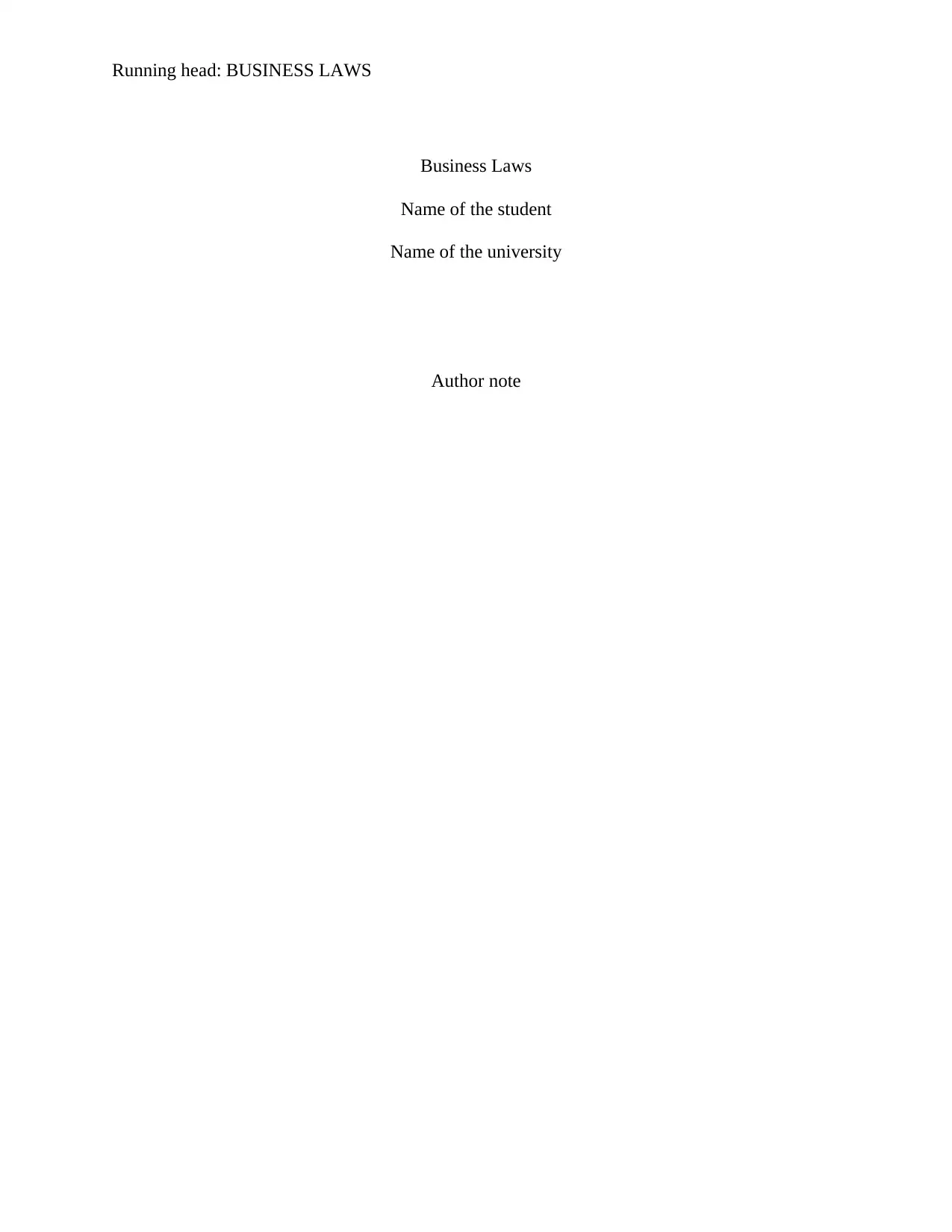
Running head: BUSINESS LAWS
Business Laws
Name of the student
Name of the university
Author note
Business Laws
Name of the student
Name of the university
Author note
Paraphrase This Document
Need a fresh take? Get an instant paraphrase of this document with our AI Paraphraser
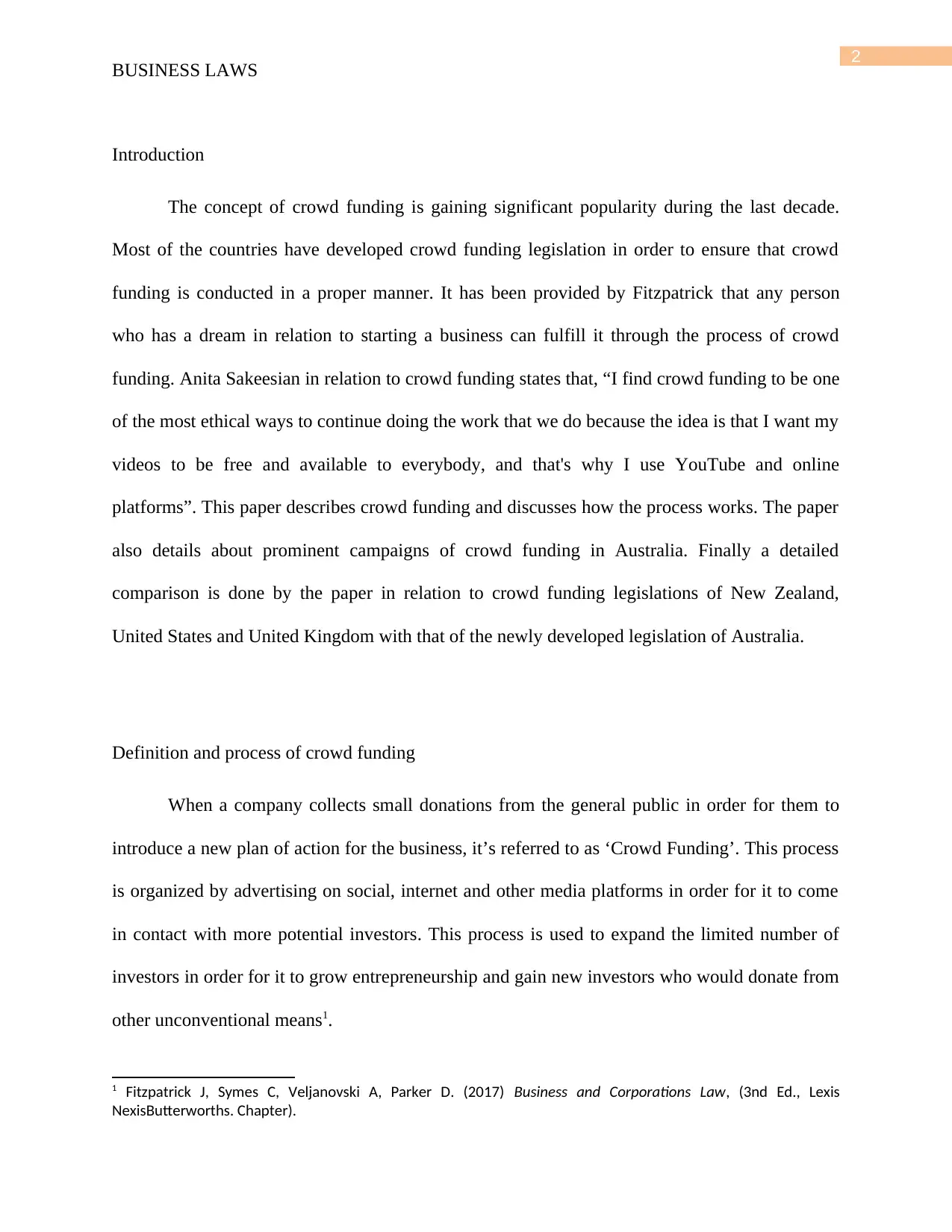
2
BUSINESS LAWS
Introduction
The concept of crowd funding is gaining significant popularity during the last decade.
Most of the countries have developed crowd funding legislation in order to ensure that crowd
funding is conducted in a proper manner. It has been provided by Fitzpatrick that any person
who has a dream in relation to starting a business can fulfill it through the process of crowd
funding. Anita Sakeesian in relation to crowd funding states that, “I find crowd funding to be one
of the most ethical ways to continue doing the work that we do because the idea is that I want my
videos to be free and available to everybody, and that's why I use YouTube and online
platforms”. This paper describes crowd funding and discusses how the process works. The paper
also details about prominent campaigns of crowd funding in Australia. Finally a detailed
comparison is done by the paper in relation to crowd funding legislations of New Zealand,
United States and United Kingdom with that of the newly developed legislation of Australia.
Definition and process of crowd funding
When a company collects small donations from the general public in order for them to
introduce a new plan of action for the business, it’s referred to as ‘Crowd Funding’. This process
is organized by advertising on social, internet and other media platforms in order for it to come
in contact with more potential investors. This process is used to expand the limited number of
investors in order for it to grow entrepreneurship and gain new investors who would donate from
other unconventional means1.
1 Fitzpatrick J, Symes C, Veljanovski A, Parker D. (2017) Business and Corporations Law, (3nd Ed., Lexis
NexisButterworths. Chapter).
BUSINESS LAWS
Introduction
The concept of crowd funding is gaining significant popularity during the last decade.
Most of the countries have developed crowd funding legislation in order to ensure that crowd
funding is conducted in a proper manner. It has been provided by Fitzpatrick that any person
who has a dream in relation to starting a business can fulfill it through the process of crowd
funding. Anita Sakeesian in relation to crowd funding states that, “I find crowd funding to be one
of the most ethical ways to continue doing the work that we do because the idea is that I want my
videos to be free and available to everybody, and that's why I use YouTube and online
platforms”. This paper describes crowd funding and discusses how the process works. The paper
also details about prominent campaigns of crowd funding in Australia. Finally a detailed
comparison is done by the paper in relation to crowd funding legislations of New Zealand,
United States and United Kingdom with that of the newly developed legislation of Australia.
Definition and process of crowd funding
When a company collects small donations from the general public in order for them to
introduce a new plan of action for the business, it’s referred to as ‘Crowd Funding’. This process
is organized by advertising on social, internet and other media platforms in order for it to come
in contact with more potential investors. This process is used to expand the limited number of
investors in order for it to grow entrepreneurship and gain new investors who would donate from
other unconventional means1.
1 Fitzpatrick J, Symes C, Veljanovski A, Parker D. (2017) Business and Corporations Law, (3nd Ed., Lexis
NexisButterworths. Chapter).
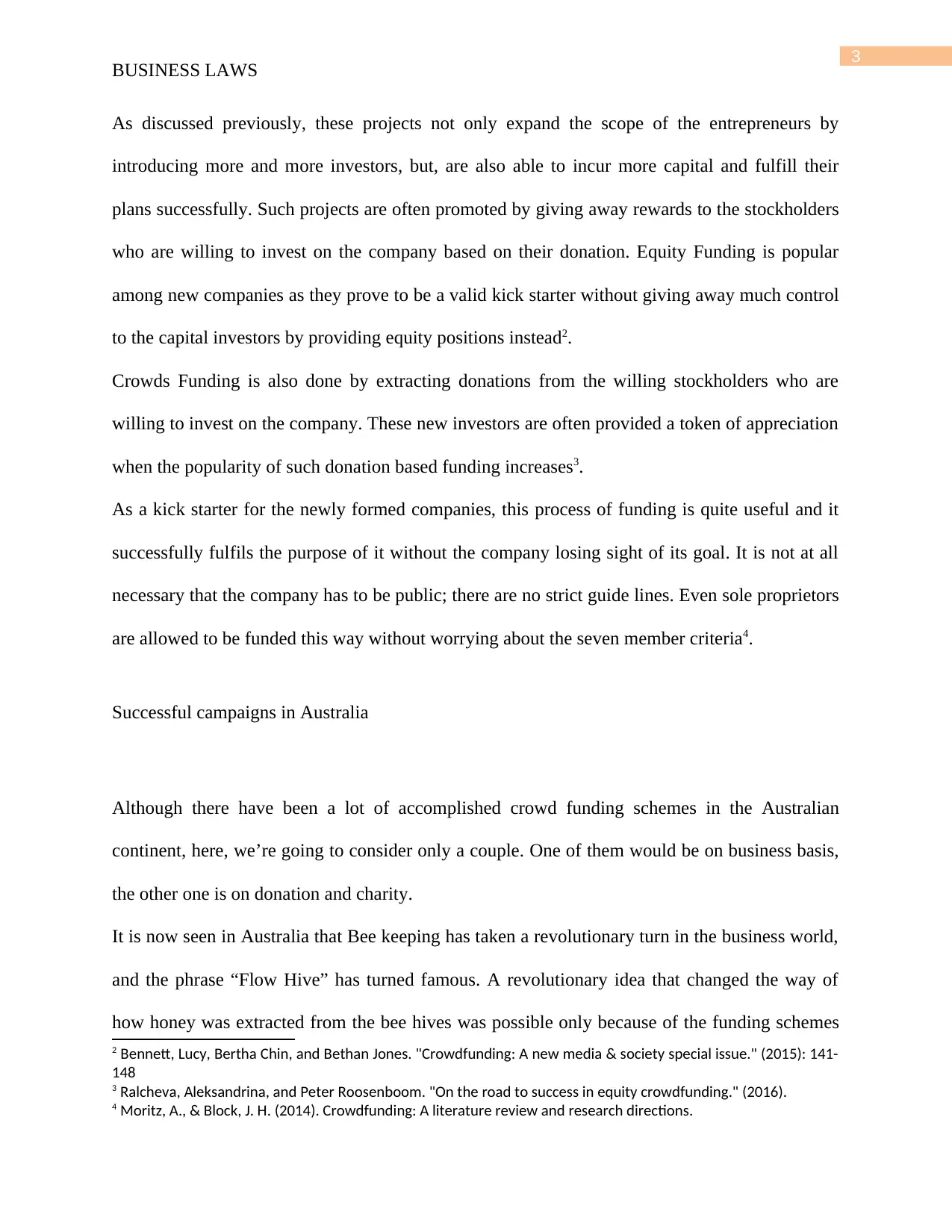
3
BUSINESS LAWS
As discussed previously, these projects not only expand the scope of the entrepreneurs by
introducing more and more investors, but, are also able to incur more capital and fulfill their
plans successfully. Such projects are often promoted by giving away rewards to the stockholders
who are willing to invest on the company based on their donation. Equity Funding is popular
among new companies as they prove to be a valid kick starter without giving away much control
to the capital investors by providing equity positions instead2.
Crowds Funding is also done by extracting donations from the willing stockholders who are
willing to invest on the company. These new investors are often provided a token of appreciation
when the popularity of such donation based funding increases3.
As a kick starter for the newly formed companies, this process of funding is quite useful and it
successfully fulfils the purpose of it without the company losing sight of its goal. It is not at all
necessary that the company has to be public; there are no strict guide lines. Even sole proprietors
are allowed to be funded this way without worrying about the seven member criteria4.
Successful campaigns in Australia
Although there have been a lot of accomplished crowd funding schemes in the Australian
continent, here, we’re going to consider only a couple. One of them would be on business basis,
the other one is on donation and charity.
It is now seen in Australia that Bee keeping has taken a revolutionary turn in the business world,
and the phrase “Flow Hive” has turned famous. A revolutionary idea that changed the way of
how honey was extracted from the bee hives was possible only because of the funding schemes
2 Bennett, Lucy, Bertha Chin, and Bethan Jones. "Crowdfunding: A new media & society special issue." (2015): 141-
148
3 Ralcheva, Aleksandrina, and Peter Roosenboom. "On the road to success in equity crowdfunding." (2016).
4 Moritz, A., & Block, J. H. (2014). Crowdfunding: A literature review and research directions.
BUSINESS LAWS
As discussed previously, these projects not only expand the scope of the entrepreneurs by
introducing more and more investors, but, are also able to incur more capital and fulfill their
plans successfully. Such projects are often promoted by giving away rewards to the stockholders
who are willing to invest on the company based on their donation. Equity Funding is popular
among new companies as they prove to be a valid kick starter without giving away much control
to the capital investors by providing equity positions instead2.
Crowds Funding is also done by extracting donations from the willing stockholders who are
willing to invest on the company. These new investors are often provided a token of appreciation
when the popularity of such donation based funding increases3.
As a kick starter for the newly formed companies, this process of funding is quite useful and it
successfully fulfils the purpose of it without the company losing sight of its goal. It is not at all
necessary that the company has to be public; there are no strict guide lines. Even sole proprietors
are allowed to be funded this way without worrying about the seven member criteria4.
Successful campaigns in Australia
Although there have been a lot of accomplished crowd funding schemes in the Australian
continent, here, we’re going to consider only a couple. One of them would be on business basis,
the other one is on donation and charity.
It is now seen in Australia that Bee keeping has taken a revolutionary turn in the business world,
and the phrase “Flow Hive” has turned famous. A revolutionary idea that changed the way of
how honey was extracted from the bee hives was possible only because of the funding schemes
2 Bennett, Lucy, Bertha Chin, and Bethan Jones. "Crowdfunding: A new media & society special issue." (2015): 141-
148
3 Ralcheva, Aleksandrina, and Peter Roosenboom. "On the road to success in equity crowdfunding." (2016).
4 Moritz, A., & Block, J. H. (2014). Crowdfunding: A literature review and research directions.
⊘ This is a preview!⊘
Do you want full access?
Subscribe today to unlock all pages.

Trusted by 1+ million students worldwide
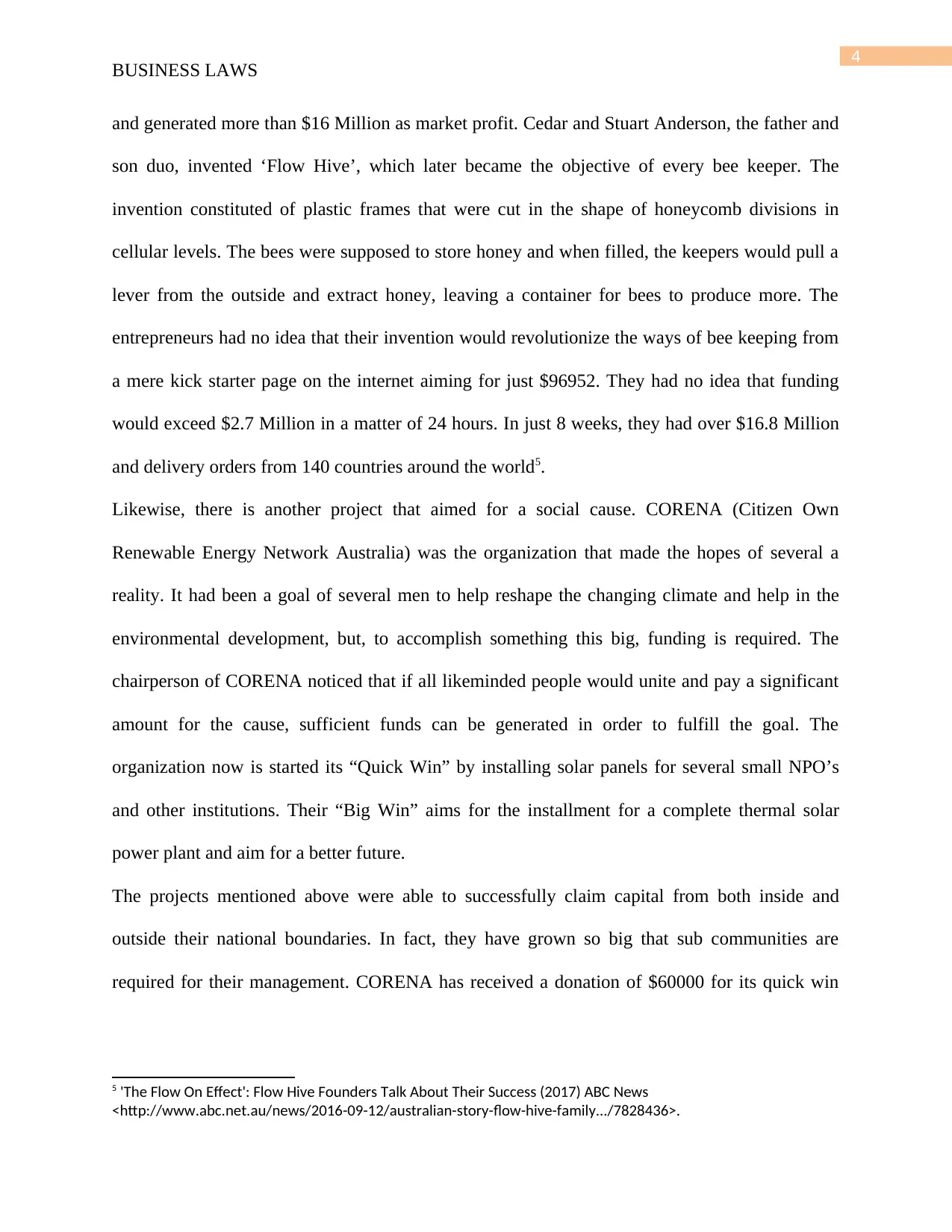
4
BUSINESS LAWS
and generated more than $16 Million as market profit. Cedar and Stuart Anderson, the father and
son duo, invented ‘Flow Hive’, which later became the objective of every bee keeper. The
invention constituted of plastic frames that were cut in the shape of honeycomb divisions in
cellular levels. The bees were supposed to store honey and when filled, the keepers would pull a
lever from the outside and extract honey, leaving a container for bees to produce more. The
entrepreneurs had no idea that their invention would revolutionize the ways of bee keeping from
a mere kick starter page on the internet aiming for just $96952. They had no idea that funding
would exceed $2.7 Million in a matter of 24 hours. In just 8 weeks, they had over $16.8 Million
and delivery orders from 140 countries around the world5.
Likewise, there is another project that aimed for a social cause. CORENA (Citizen Own
Renewable Energy Network Australia) was the organization that made the hopes of several a
reality. It had been a goal of several men to help reshape the changing climate and help in the
environmental development, but, to accomplish something this big, funding is required. The
chairperson of CORENA noticed that if all likeminded people would unite and pay a significant
amount for the cause, sufficient funds can be generated in order to fulfill the goal. The
organization now is started its “Quick Win” by installing solar panels for several small NPO’s
and other institutions. Their “Big Win” aims for the installment for a complete thermal solar
power plant and aim for a better future.
The projects mentioned above were able to successfully claim capital from both inside and
outside their national boundaries. In fact, they have grown so big that sub communities are
required for their management. CORENA has received a donation of $60000 for its quick win
5 'The Flow On Effect': Flow Hive Founders Talk About Their Success (2017) ABC News
<http://www.abc.net.au/news/2016-09-12/australian-story-flow-hive-family.../7828436>.
BUSINESS LAWS
and generated more than $16 Million as market profit. Cedar and Stuart Anderson, the father and
son duo, invented ‘Flow Hive’, which later became the objective of every bee keeper. The
invention constituted of plastic frames that were cut in the shape of honeycomb divisions in
cellular levels. The bees were supposed to store honey and when filled, the keepers would pull a
lever from the outside and extract honey, leaving a container for bees to produce more. The
entrepreneurs had no idea that their invention would revolutionize the ways of bee keeping from
a mere kick starter page on the internet aiming for just $96952. They had no idea that funding
would exceed $2.7 Million in a matter of 24 hours. In just 8 weeks, they had over $16.8 Million
and delivery orders from 140 countries around the world5.
Likewise, there is another project that aimed for a social cause. CORENA (Citizen Own
Renewable Energy Network Australia) was the organization that made the hopes of several a
reality. It had been a goal of several men to help reshape the changing climate and help in the
environmental development, but, to accomplish something this big, funding is required. The
chairperson of CORENA noticed that if all likeminded people would unite and pay a significant
amount for the cause, sufficient funds can be generated in order to fulfill the goal. The
organization now is started its “Quick Win” by installing solar panels for several small NPO’s
and other institutions. Their “Big Win” aims for the installment for a complete thermal solar
power plant and aim for a better future.
The projects mentioned above were able to successfully claim capital from both inside and
outside their national boundaries. In fact, they have grown so big that sub communities are
required for their management. CORENA has received a donation of $60000 for its quick win
5 'The Flow On Effect': Flow Hive Founders Talk About Their Success (2017) ABC News
<http://www.abc.net.au/news/2016-09-12/australian-story-flow-hive-family.../7828436>.
Paraphrase This Document
Need a fresh take? Get an instant paraphrase of this document with our AI Paraphraser
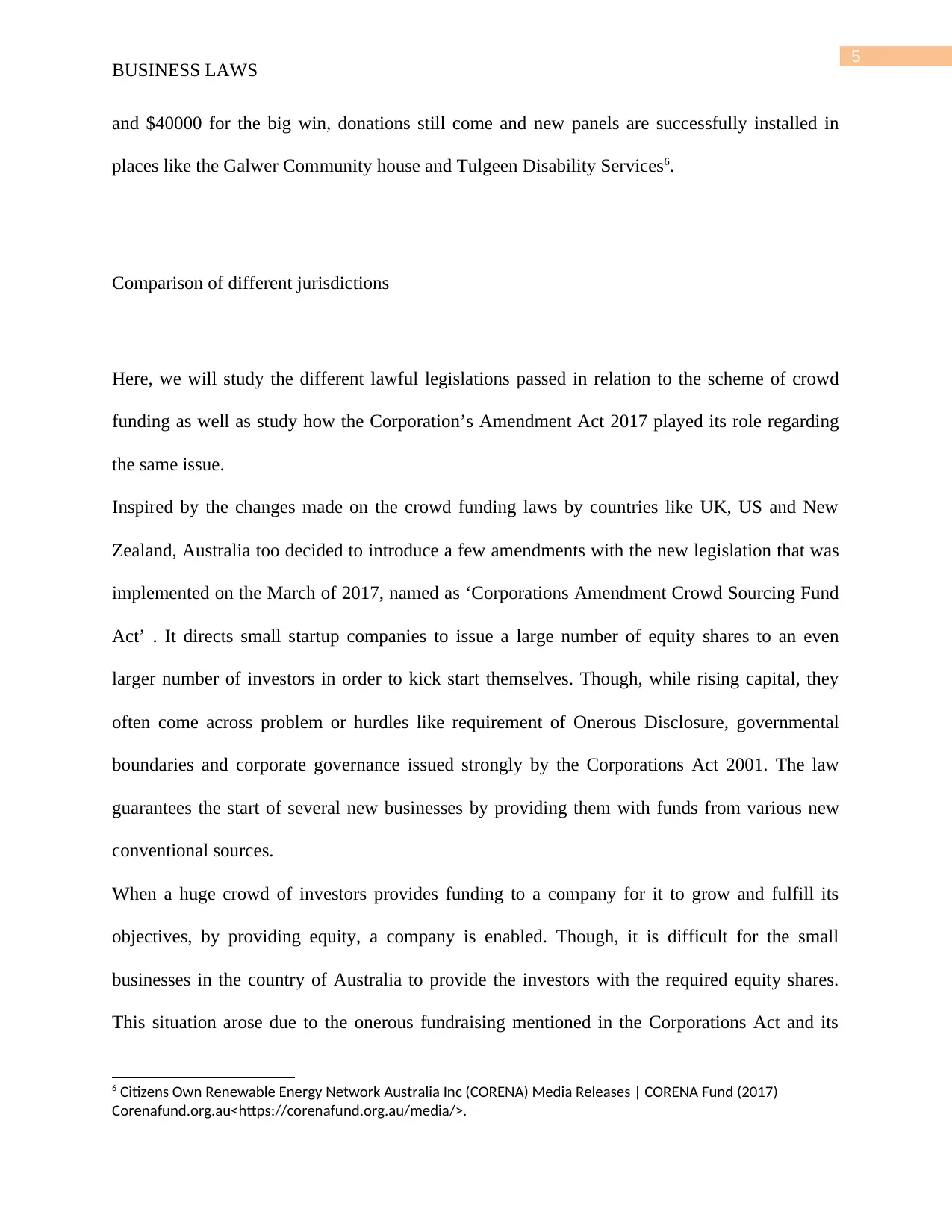
5
BUSINESS LAWS
and $40000 for the big win, donations still come and new panels are successfully installed in
places like the Galwer Community house and Tulgeen Disability Services6.
Comparison of different jurisdictions
Here, we will study the different lawful legislations passed in relation to the scheme of crowd
funding as well as study how the Corporation’s Amendment Act 2017 played its role regarding
the same issue.
Inspired by the changes made on the crowd funding laws by countries like UK, US and New
Zealand, Australia too decided to introduce a few amendments with the new legislation that was
implemented on the March of 2017, named as ‘Corporations Amendment Crowd Sourcing Fund
Act’ . It directs small startup companies to issue a large number of equity shares to an even
larger number of investors in order to kick start themselves. Though, while rising capital, they
often come across problem or hurdles like requirement of Onerous Disclosure, governmental
boundaries and corporate governance issued strongly by the Corporations Act 2001. The law
guarantees the start of several new businesses by providing them with funds from various new
conventional sources.
When a huge crowd of investors provides funding to a company for it to grow and fulfill its
objectives, by providing equity, a company is enabled. Though, it is difficult for the small
businesses in the country of Australia to provide the investors with the required equity shares.
This situation arose due to the onerous fundraising mentioned in the Corporations Act and its
6 Citizens Own Renewable Energy Network Australia Inc (CORENA) Media Releases | CORENA Fund (2017)
Corenafund.org.au<https://corenafund.org.au/media/>.
BUSINESS LAWS
and $40000 for the big win, donations still come and new panels are successfully installed in
places like the Galwer Community house and Tulgeen Disability Services6.
Comparison of different jurisdictions
Here, we will study the different lawful legislations passed in relation to the scheme of crowd
funding as well as study how the Corporation’s Amendment Act 2017 played its role regarding
the same issue.
Inspired by the changes made on the crowd funding laws by countries like UK, US and New
Zealand, Australia too decided to introduce a few amendments with the new legislation that was
implemented on the March of 2017, named as ‘Corporations Amendment Crowd Sourcing Fund
Act’ . It directs small startup companies to issue a large number of equity shares to an even
larger number of investors in order to kick start themselves. Though, while rising capital, they
often come across problem or hurdles like requirement of Onerous Disclosure, governmental
boundaries and corporate governance issued strongly by the Corporations Act 2001. The law
guarantees the start of several new businesses by providing them with funds from various new
conventional sources.
When a huge crowd of investors provides funding to a company for it to grow and fulfill its
objectives, by providing equity, a company is enabled. Though, it is difficult for the small
businesses in the country of Australia to provide the investors with the required equity shares.
This situation arose due to the onerous fundraising mentioned in the Corporations Act and its
6 Citizens Own Renewable Energy Network Australia Inc (CORENA) Media Releases | CORENA Fund (2017)
Corenafund.org.au<https://corenafund.org.au/media/>.
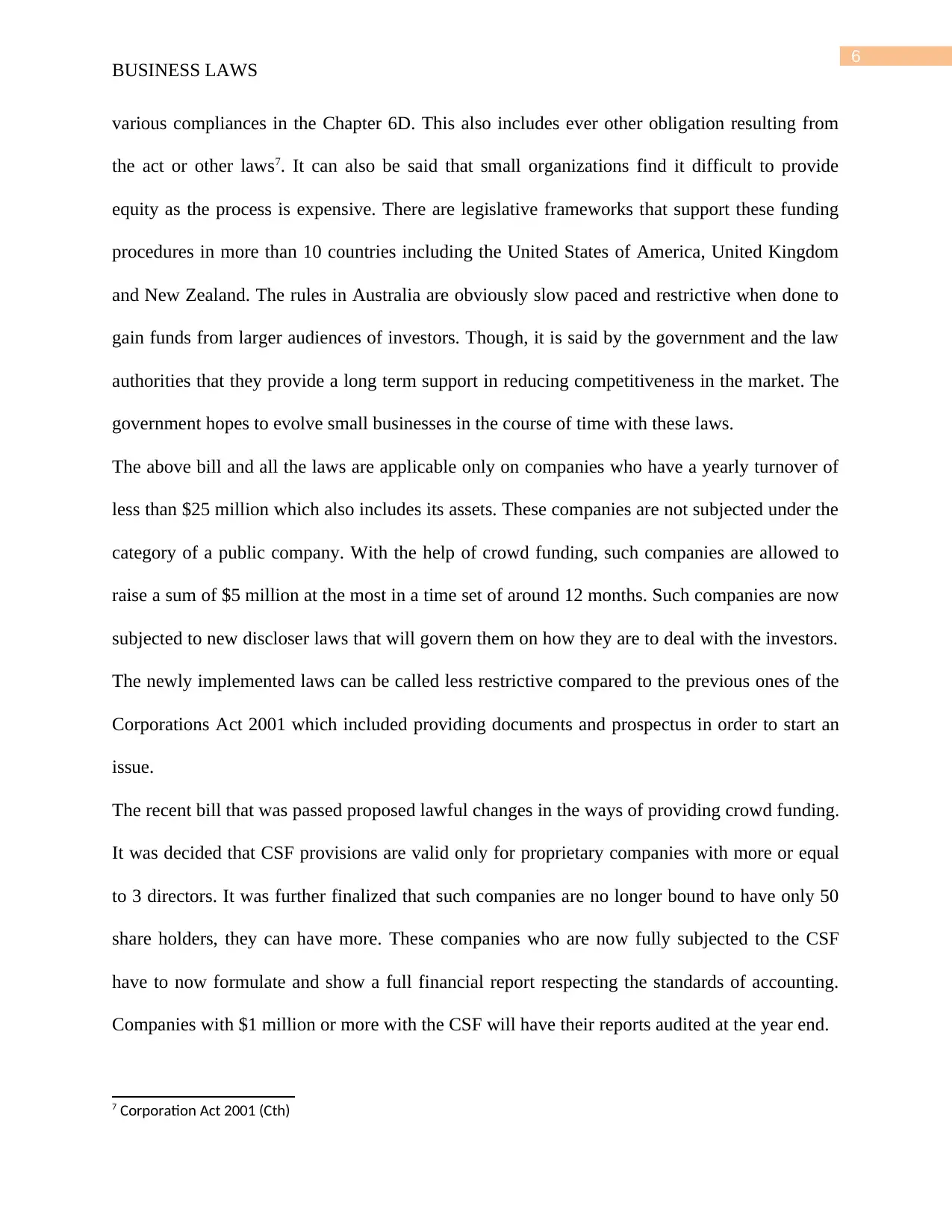
6
BUSINESS LAWS
various compliances in the Chapter 6D. This also includes ever other obligation resulting from
the act or other laws7. It can also be said that small organizations find it difficult to provide
equity as the process is expensive. There are legislative frameworks that support these funding
procedures in more than 10 countries including the United States of America, United Kingdom
and New Zealand. The rules in Australia are obviously slow paced and restrictive when done to
gain funds from larger audiences of investors. Though, it is said by the government and the law
authorities that they provide a long term support in reducing competitiveness in the market. The
government hopes to evolve small businesses in the course of time with these laws.
The above bill and all the laws are applicable only on companies who have a yearly turnover of
less than $25 million which also includes its assets. These companies are not subjected under the
category of a public company. With the help of crowd funding, such companies are allowed to
raise a sum of $5 million at the most in a time set of around 12 months. Such companies are now
subjected to new discloser laws that will govern them on how they are to deal with the investors.
The newly implemented laws can be called less restrictive compared to the previous ones of the
Corporations Act 2001 which included providing documents and prospectus in order to start an
issue.
The recent bill that was passed proposed lawful changes in the ways of providing crowd funding.
It was decided that CSF provisions are valid only for proprietary companies with more or equal
to 3 directors. It was further finalized that such companies are no longer bound to have only 50
share holders, they can have more. These companies who are now fully subjected to the CSF
have to now formulate and show a full financial report respecting the standards of accounting.
Companies with $1 million or more with the CSF will have their reports audited at the year end.
7 Corporation Act 2001 (Cth)
BUSINESS LAWS
various compliances in the Chapter 6D. This also includes ever other obligation resulting from
the act or other laws7. It can also be said that small organizations find it difficult to provide
equity as the process is expensive. There are legislative frameworks that support these funding
procedures in more than 10 countries including the United States of America, United Kingdom
and New Zealand. The rules in Australia are obviously slow paced and restrictive when done to
gain funds from larger audiences of investors. Though, it is said by the government and the law
authorities that they provide a long term support in reducing competitiveness in the market. The
government hopes to evolve small businesses in the course of time with these laws.
The above bill and all the laws are applicable only on companies who have a yearly turnover of
less than $25 million which also includes its assets. These companies are not subjected under the
category of a public company. With the help of crowd funding, such companies are allowed to
raise a sum of $5 million at the most in a time set of around 12 months. Such companies are now
subjected to new discloser laws that will govern them on how they are to deal with the investors.
The newly implemented laws can be called less restrictive compared to the previous ones of the
Corporations Act 2001 which included providing documents and prospectus in order to start an
issue.
The recent bill that was passed proposed lawful changes in the ways of providing crowd funding.
It was decided that CSF provisions are valid only for proprietary companies with more or equal
to 3 directors. It was further finalized that such companies are no longer bound to have only 50
share holders, they can have more. These companies who are now fully subjected to the CSF
have to now formulate and show a full financial report respecting the standards of accounting.
Companies with $1 million or more with the CSF will have their reports audited at the year end.
7 Corporation Act 2001 (Cth)
⊘ This is a preview!⊘
Do you want full access?
Subscribe today to unlock all pages.

Trusted by 1+ million students worldwide
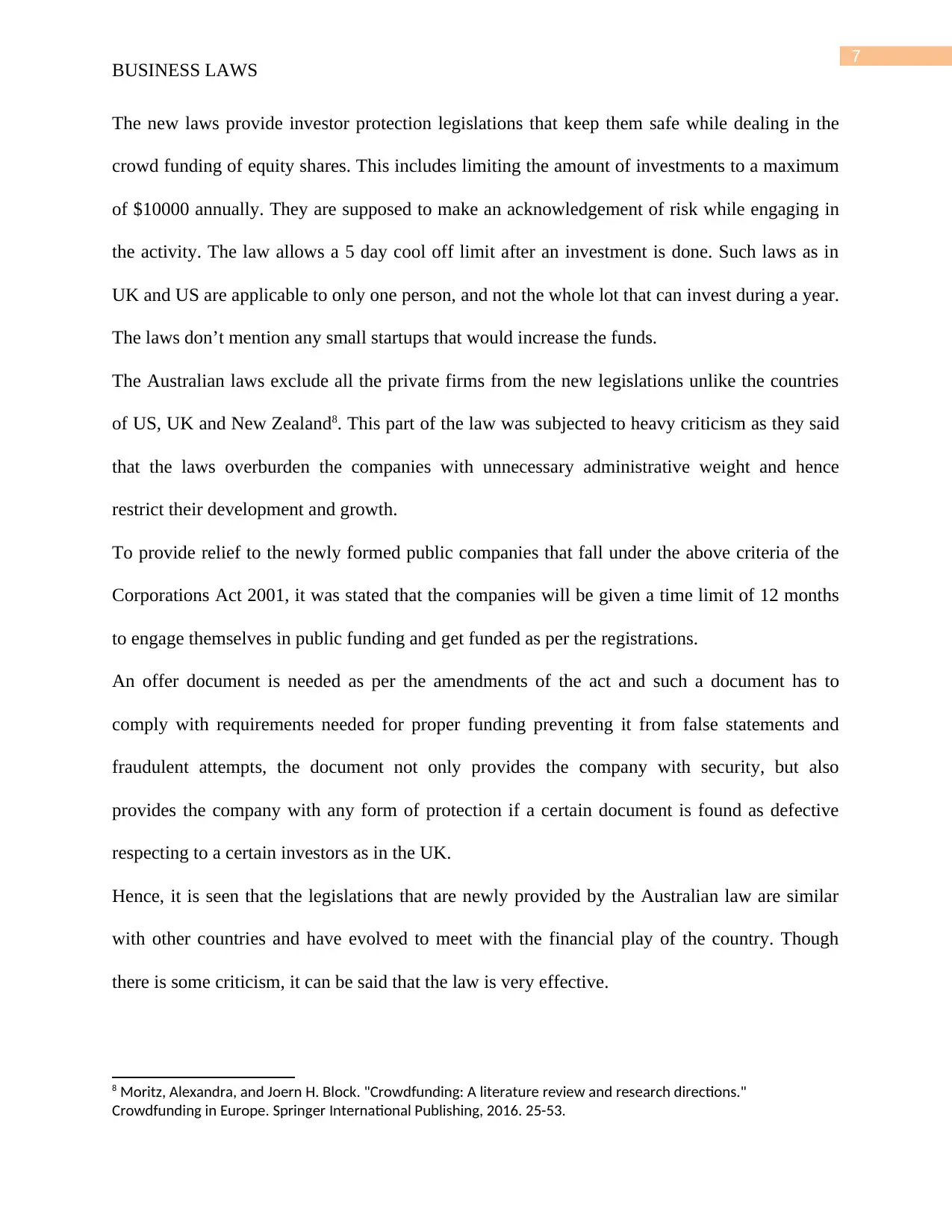
7
BUSINESS LAWS
The new laws provide investor protection legislations that keep them safe while dealing in the
crowd funding of equity shares. This includes limiting the amount of investments to a maximum
of $10000 annually. They are supposed to make an acknowledgement of risk while engaging in
the activity. The law allows a 5 day cool off limit after an investment is done. Such laws as in
UK and US are applicable to only one person, and not the whole lot that can invest during a year.
The laws don’t mention any small startups that would increase the funds.
The Australian laws exclude all the private firms from the new legislations unlike the countries
of US, UK and New Zealand8. This part of the law was subjected to heavy criticism as they said
that the laws overburden the companies with unnecessary administrative weight and hence
restrict their development and growth.
To provide relief to the newly formed public companies that fall under the above criteria of the
Corporations Act 2001, it was stated that the companies will be given a time limit of 12 months
to engage themselves in public funding and get funded as per the registrations.
An offer document is needed as per the amendments of the act and such a document has to
comply with requirements needed for proper funding preventing it from false statements and
fraudulent attempts, the document not only provides the company with security, but also
provides the company with any form of protection if a certain document is found as defective
respecting to a certain investors as in the UK.
Hence, it is seen that the legislations that are newly provided by the Australian law are similar
with other countries and have evolved to meet with the financial play of the country. Though
there is some criticism, it can be said that the law is very effective.
8 Moritz, Alexandra, and Joern H. Block. "Crowdfunding: A literature review and research directions."
Crowdfunding in Europe. Springer International Publishing, 2016. 25-53.
BUSINESS LAWS
The new laws provide investor protection legislations that keep them safe while dealing in the
crowd funding of equity shares. This includes limiting the amount of investments to a maximum
of $10000 annually. They are supposed to make an acknowledgement of risk while engaging in
the activity. The law allows a 5 day cool off limit after an investment is done. Such laws as in
UK and US are applicable to only one person, and not the whole lot that can invest during a year.
The laws don’t mention any small startups that would increase the funds.
The Australian laws exclude all the private firms from the new legislations unlike the countries
of US, UK and New Zealand8. This part of the law was subjected to heavy criticism as they said
that the laws overburden the companies with unnecessary administrative weight and hence
restrict their development and growth.
To provide relief to the newly formed public companies that fall under the above criteria of the
Corporations Act 2001, it was stated that the companies will be given a time limit of 12 months
to engage themselves in public funding and get funded as per the registrations.
An offer document is needed as per the amendments of the act and such a document has to
comply with requirements needed for proper funding preventing it from false statements and
fraudulent attempts, the document not only provides the company with security, but also
provides the company with any form of protection if a certain document is found as defective
respecting to a certain investors as in the UK.
Hence, it is seen that the legislations that are newly provided by the Australian law are similar
with other countries and have evolved to meet with the financial play of the country. Though
there is some criticism, it can be said that the law is very effective.
8 Moritz, Alexandra, and Joern H. Block. "Crowdfunding: A literature review and research directions."
Crowdfunding in Europe. Springer International Publishing, 2016. 25-53.
Paraphrase This Document
Need a fresh take? Get an instant paraphrase of this document with our AI Paraphraser
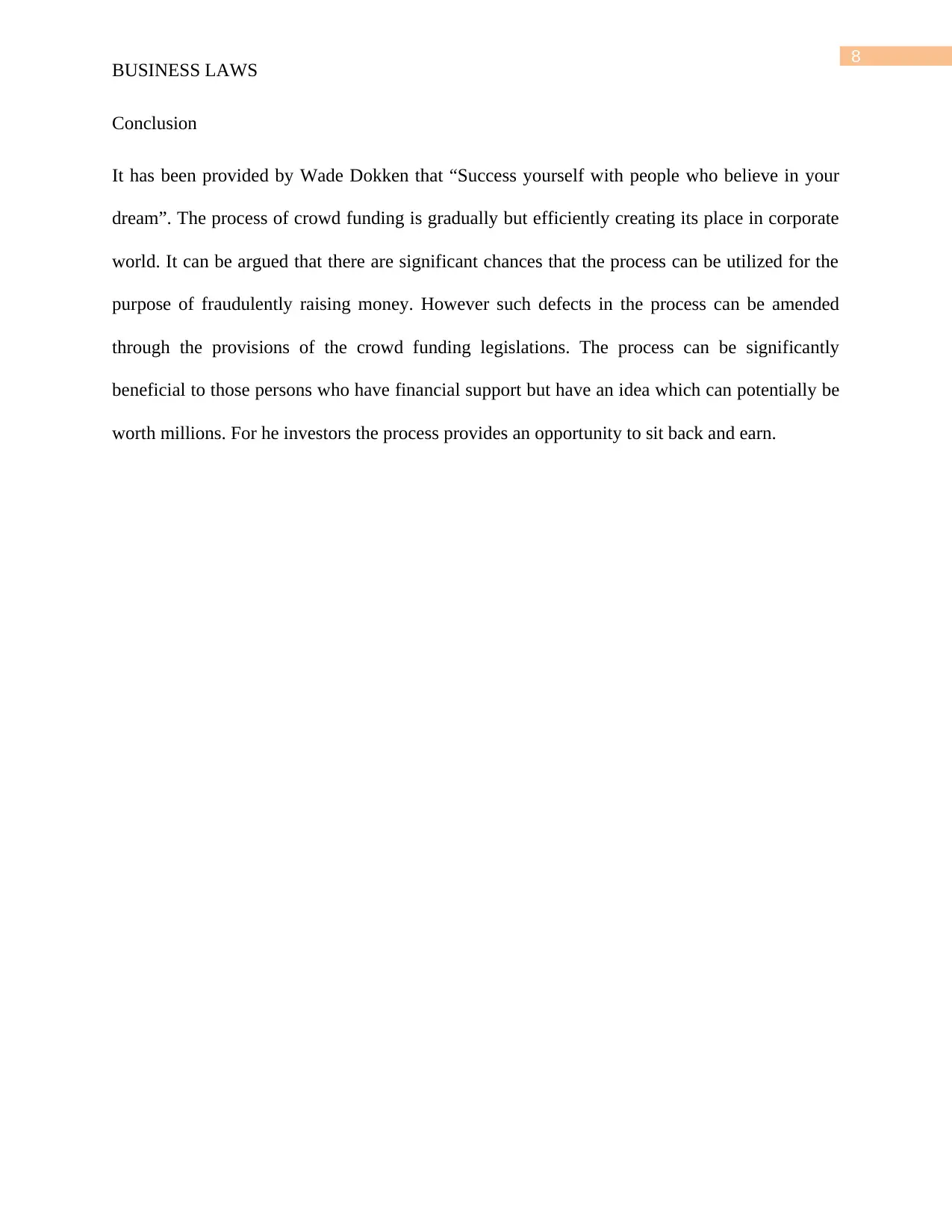
8
BUSINESS LAWS
Conclusion
It has been provided by Wade Dokken that “Success yourself with people who believe in your
dream”. The process of crowd funding is gradually but efficiently creating its place in corporate
world. It can be argued that there are significant chances that the process can be utilized for the
purpose of fraudulently raising money. However such defects in the process can be amended
through the provisions of the crowd funding legislations. The process can be significantly
beneficial to those persons who have financial support but have an idea which can potentially be
worth millions. For he investors the process provides an opportunity to sit back and earn.
BUSINESS LAWS
Conclusion
It has been provided by Wade Dokken that “Success yourself with people who believe in your
dream”. The process of crowd funding is gradually but efficiently creating its place in corporate
world. It can be argued that there are significant chances that the process can be utilized for the
purpose of fraudulently raising money. However such defects in the process can be amended
through the provisions of the crowd funding legislations. The process can be significantly
beneficial to those persons who have financial support but have an idea which can potentially be
worth millions. For he investors the process provides an opportunity to sit back and earn.
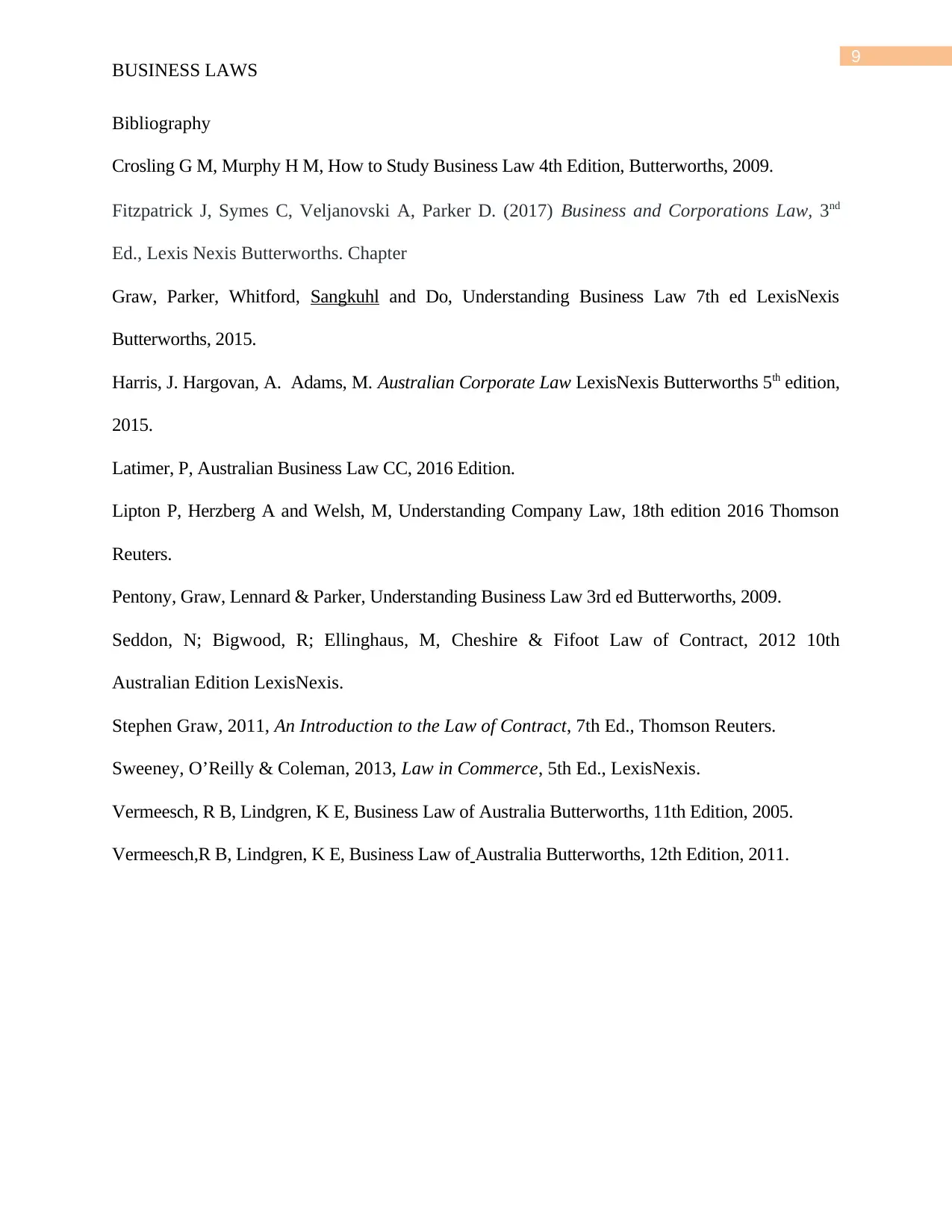
9
BUSINESS LAWS
Bibliography
Crosling G M, Murphy H M, How to Study Business Law 4th Edition, Butterworths, 2009.
Fitzpatrick J, Symes C, Veljanovski A, Parker D. (2017) Business and Corporations Law, 3nd
Ed., Lexis Nexis Butterworths. Chapter
Graw, Parker, Whitford, Sangkuhl and Do, Understanding Business Law 7th ed LexisNexis
Butterworths, 2015.
Harris, J. Hargovan, A. Adams, M. Australian Corporate Law LexisNexis Butterworths 5th edition,
2015.
Latimer, P, Australian Business Law CC, 2016 Edition.
Lipton P, Herzberg A and Welsh, M, Understanding Company Law, 18th edition 2016 Thomson
Reuters.
Pentony, Graw, Lennard & Parker, Understanding Business Law 3rd ed Butterworths, 2009.
Seddon, N; Bigwood, R; Ellinghaus, M, Cheshire & Fifoot Law of Contract, 2012 10th
Australian Edition LexisNexis.
Stephen Graw, 2011, An Introduction to the Law of Contract, 7th Ed., Thomson Reuters.
Sweeney, O’Reilly & Coleman, 2013, Law in Commerce, 5th Ed., LexisNexis.
Vermeesch, R B, Lindgren, K E, Business Law of Australia Butterworths, 11th Edition, 2005.
Vermeesch,R B, Lindgren, K E, Business Law of Australia Butterworths, 12th Edition, 2011.
BUSINESS LAWS
Bibliography
Crosling G M, Murphy H M, How to Study Business Law 4th Edition, Butterworths, 2009.
Fitzpatrick J, Symes C, Veljanovski A, Parker D. (2017) Business and Corporations Law, 3nd
Ed., Lexis Nexis Butterworths. Chapter
Graw, Parker, Whitford, Sangkuhl and Do, Understanding Business Law 7th ed LexisNexis
Butterworths, 2015.
Harris, J. Hargovan, A. Adams, M. Australian Corporate Law LexisNexis Butterworths 5th edition,
2015.
Latimer, P, Australian Business Law CC, 2016 Edition.
Lipton P, Herzberg A and Welsh, M, Understanding Company Law, 18th edition 2016 Thomson
Reuters.
Pentony, Graw, Lennard & Parker, Understanding Business Law 3rd ed Butterworths, 2009.
Seddon, N; Bigwood, R; Ellinghaus, M, Cheshire & Fifoot Law of Contract, 2012 10th
Australian Edition LexisNexis.
Stephen Graw, 2011, An Introduction to the Law of Contract, 7th Ed., Thomson Reuters.
Sweeney, O’Reilly & Coleman, 2013, Law in Commerce, 5th Ed., LexisNexis.
Vermeesch, R B, Lindgren, K E, Business Law of Australia Butterworths, 11th Edition, 2005.
Vermeesch,R B, Lindgren, K E, Business Law of Australia Butterworths, 12th Edition, 2011.
⊘ This is a preview!⊘
Do you want full access?
Subscribe today to unlock all pages.

Trusted by 1+ million students worldwide
1 out of 9
Related Documents
Your All-in-One AI-Powered Toolkit for Academic Success.
+13062052269
info@desklib.com
Available 24*7 on WhatsApp / Email
![[object Object]](/_next/static/media/star-bottom.7253800d.svg)
Unlock your academic potential
Copyright © 2020–2025 A2Z Services. All Rights Reserved. Developed and managed by ZUCOL.



